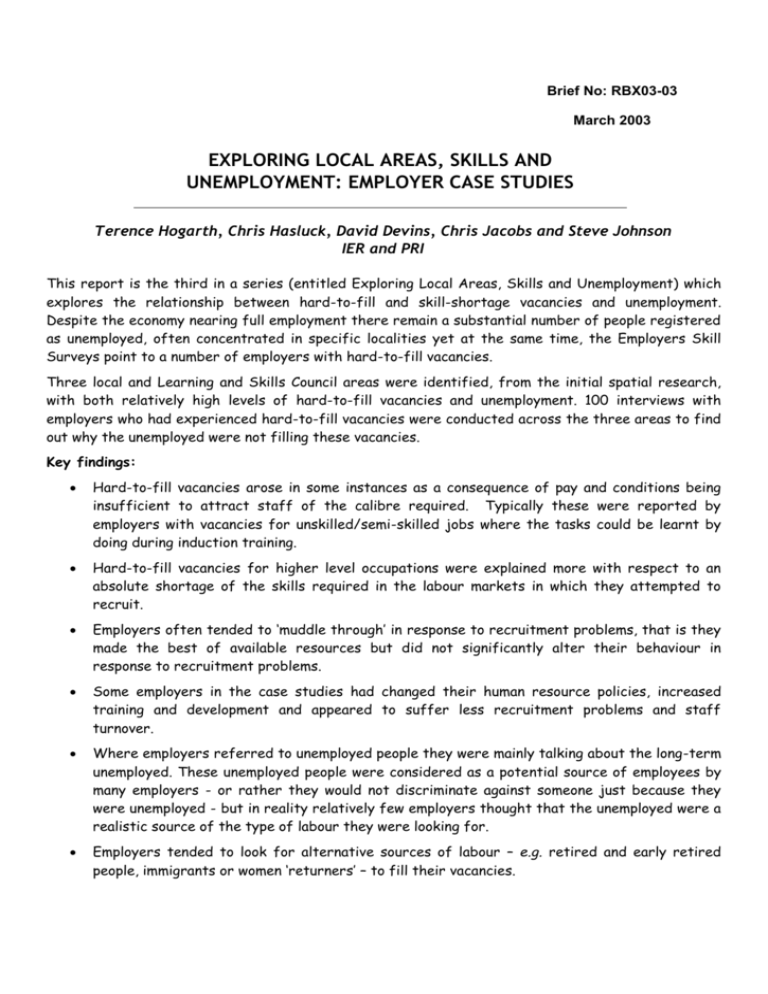Exploring local areas, skills and unemployment
advertisement

Brief No: RBX03-03 March 2003 EXPLORING LOCAL AREAS, SKILLS AND UNEMPLOYMENT: EMPLOYER CASE STUDIES Terence Hogarth, Chris Hasluck, David Devins, Chris Jacobs and Steve Johnson IER and PRI This report is the third in a series (entitled Exploring Local Areas, Skills and Unemployment) which explores the relationship between hard-to-fill and skill-shortage vacancies and unemployment. Despite the economy nearing full employment there remain a substantial number of people registered as unemployed, often concentrated in specific localities yet at the same time, the Employers Skill Surveys point to a number of employers with hard-to-fill vacancies. Three local and Learning and Skills Council areas were identified, from the initial spatial research, with both relatively high levels of hard-to-fill vacancies and unemployment. 100 interviews with employers who had experienced hard-to-fill vacancies were conducted across the three areas to find out why the unemployed were not filling these vacancies. Key findings: Hard-to-fill vacancies arose in some instances as a consequence of pay and conditions being insufficient to attract staff of the calibre required. Typically these were reported by employers with vacancies for unskilled/semi-skilled jobs where the tasks could be learnt by doing during induction training. Hard-to-fill vacancies for higher level occupations were explained more with respect to an absolute shortage of the skills required in the labour markets in which they attempted to recruit. Employers often tended to ‘muddle through’ in response to recruitment problems, that is they made the best of available resources but did not significantly alter their behaviour in response to recruitment problems. Some employers in the case studies had changed their human resource policies, increased training and development and appeared to suffer less recruitment problems and staff turnover. Where employers referred to unemployed people they were mainly talking about the long-term unemployed. These unemployed people were considered as a potential source of employees by many employers - or rather they would not discriminate against someone just because they were unemployed - but in reality relatively few employers thought that the unemployed were a realistic source of the type of labour they were looking for. Employers tended to look for alternative sources of labour – e.g. retired and early retired people, immigrants or women ‘returners’ – to fill their vacancies. Background This Employer Case Studies report builds on analysis of the Employers Skill Survey for 1999 which suggested that in a number of locations there were high levels of unemployment and yet employers were still having serious recruitment problems. The Exploring Local Areas, Skills and Unemployment study was designed to explore the relationship between recruitment problems and unemployment. It was multi-faceted, based around three main elements: Exploratory Data Analysis at Local Area Level spatial analysis of the characteristics of vacancies, hard-to-fill vacancies (HtFVs), and skill-shortage vacancies (SSVs) at the level of Local Learning and Skills Council (LLSC) areas using data from the Employers Skill Survey 2001 (ESS2001);i The Relationship between Vacancies and Local Unemployment: multivariate econometric analysis of ESS2001, aimed at identifying the factors associated with the incidence and intensity of recruitment problems, including the influence of unemployment rates at the local level;ii Employer Case Studies qualitative interviews with employers experiencing recruitment problems in three LLSC areas exhibiting relatively high levels of HtFVs and unemployment, as identified by the spatial analysis. A synthesis report which brings together the three components of the research is available: iii Skill Shortages, Vacancies and Local Unemployment: A Synthesis of the Exploring Local Areas, Skills and Unemployment Analyses. The ESS evidence has revealed many of these HtFVs to be in relatively low skilled jobs suggesting that they can be potentially filled by most people. In other words, the skills required to fill the jobs are general, low level ones possessed by the majority of the working age population. Previous research on the relationship between the relatively high rates of unemployment and HtFVs has been described as a paradox, inferring that in some way the labour market is not operating as expected. Based on case study analysis of employers’ recruitment practices in three local LSCs exhibiting relatively high levels of unemployment and hard-to-fill vacancies (Birmingham/Solihull; East London; and Lancashire) explanations of the apparent paradox are explored. Explaining hard-to-fill vacancies The case studies found that hard-to-fill vacancies arose in some instances as a consequence of pay and conditions being unable to attract staff of the calibre required. Typically these were reported by employers with vacancies for unskilled/semiskilled jobs where the tasks could be learnt by doing during induction training. Hard-tofill vacancies for higher level occupations were explained more with respect to an absolute shortage of the skills required in the labour markets in which they attempted to recruit. Responses to recruitment problems The analysis shows that employers tended to ‘muddle through’ in response to recruitment problems, that is they made the best of available resources but did not significantly alter their behaviour in response to recruitment problems. Other human employers had more responsive resource policies. They gave attention to maintaining levels of staff retention (for example offering more flexible hours of work), or providing greater training and development opportunities. Some employers reasoned that if it was impossible to recruit fully experienced skilled workers, the only alternative was to train their own to the required standard. This also offered some form of career progression and was mutually supporting of labour retention policies. Unemployed and economically inactive people The interviews highlight that where employers referred to unemployed people they were mainly talking about the longterm unemployed, but it was not clear how employers defined ‘long-term’. Unemployed people were considered as a potential source of employees by many employers - or rather they would not discriminate against someone just because they were unemployed - but in reality relatively few employers thought that the unemployed were a realistic source of the type of labour they were looking for. More attention was paid to the economically inactive and the capacity of retired or early retired workers and ‘women returners’. In London immigrants with leave to stay in the country were also targeted to fill jobs. Ways in which the unemployed are disadvantaged in the labour market include: recruitment practices that favour informal methods (word-of-mouth, use of business networks) mean that unemployed people might never be aware of a vacancy; a disinclination by the employers surveyed (who were all employers who had experienced hard to fill vacancies) to use the Jobcentre to advertise vacancies - one of the principal sources for jobs for those signing on the unemployed register; a perception by employers that unemployed people would not possess the skills they required, by definition, of them being unemployed. Inefficient operation of local labour markets The research asks what might explain the so-called ‘paradox’ between the coexistence of relatively high levels of unemployment and HtFVs? The analysis found that many HtFVs result from employers having a specific set of requirements in mind for a would-be recruit. They are willing to lower their recruitment standards to an extent, but they nevertheless require recruits to meet the job specification within a short-period of time (the probationary period). If that standard cannot be reached then some employers were willing to let a vacancy lapse because the costs of recruiting an unsuitable applicant are thought to be greater than not recruiting at all. It should be borne in mind that the administration associated with hiring and firing can be costly as well – as reported by several respondents in larger organisations. Occupational and/or geographical immobility The evidence from Lancashire points to its more rural areas being a source of recruitment problems. Where employers occupy a rather remote location and have vacancies for relatively low paid jobs, then the capacity of people to travel far to fill those jobs is limited by the availability of public transport and the costs of travel. This is not, however, a problem unique to rural locations. They may be more acute there, but in Birmingham/Solihull and East London the ability of people to travel far when jobs are low paid means that employers are also dependent upon the local labour market in their immediate vicinity. This is exacerbated further when shift work is required and/or early morning starts when public transport might not be available. Wages and conditions of employment In many respects HtFVs resulted because employers were not offering terms and conditions that were competitive in their local labour market. If they raised their wage levels or improved conditions they might have been able to attract labour of the quality desired and improve supply over the longer-term. Relative wage levels, and other terms and conditions of employment, are also likely to be related to labour retention. An inability to recruit staff because wages are low for example, is also likely to be related to problems retaining staff if better jobs are available elsewhere. The report indicates that high labour turnover is a major cause of recruitment problems. The evidence presented in this report suggests that employers that have resorted to increased training and development of their workforce, allied to staff retention policies, have had a degree of success in avoiding recruitment problems. Additional Information The reports are available electronically, free of charge, on the Skillsbase website www.skillsbase.dfee.gov.uk or the research website www.dfes.gov.uk/research/ . Hard copies are available from Prolog: 0845 60 222 60 or email dfes@prolog.uk.com quoting code ELA 1 - 4. For further information contact Vikki Caulfield: email vikki.caulfield@dfes.gsi.gov.uk or Tel 0114 259 4309. Copies of this Research Brief (RBX03-03) are available free of charge from DfES Publications, PO Box 5050, Sherwood Park, Annesley, Nottingham, NG15 0DJ. i Green, A.E. and D. Owen (2002). Exploring Local Areas, Skills and Unemployment: Exploratory Data Analysis at Local Area Level, Department for Education and Skills. ii Dickerson A.P. (2003). Exploring Local Areas, Skills and Unemployment: The Relationship Between Vacancies and Local Unemployment: Department for Education and Skills. iii Hogarth, T. et al 2003 Skill Shortages, Vacancies and Local Unemployment: a Synthesis of the Exploring Local Areas, Skills and Unemployment Analyses: Department for Education and Skills.





